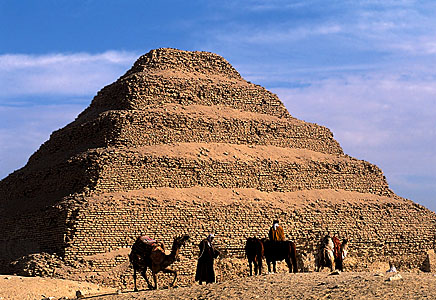Menes
conquered the Delta using copper arrow-heads, but by 2500 the Sumerians had
discovered that if you add 10% of tin to soft copper, the
result is the very hard bronze with which it became
possible to make real swords.
The spread of the use of bronze indicates the passage
from Stone Age (Neolithic) to Bronze Age, a transition
that seems to happen in Western Europe and China at about the
same time, independently.
Since tin is rarer than copper, it
was necessary to mine it and import it, international trade and
banking had begun. At
about this time too, cities began to build protective walls, and
the number of weapons grew, humanity had discovered war. The citadel of Troy
was probably founded around 2500 to protect the ships passing
through the Dardanelles carrying tin.
Egypt developed very
early a remarkable monumental culture familiar to everyone. Yet
it remained largely isolated by the desert from other developed
cultures, while the Egyptian cult
of the dead has no parallel elsewhere. The system of
writing in pictograms known as hieroglyphics was
established at the beginning of the Old Kingdom and remained
unchanged until the end of Egyptian culture during the Roman
Empire.
The Old Kingdom collapsed in part
because the construction of pyramids and the entire cult of the
dead demanded too much from the country's population. It was
followed by the Middle Kingdom in 2050. This social
system collapsed in about 1750 because of power-conflicts
between pharaohs and nobility and the Hyksos from
Canaan and Syria took control of Egypt until they were expelled
in 1560 and the New Kingdom was established, lasting
until 1087.

Worship of the
sun by Amenhotep IV (Akhenaton)
|
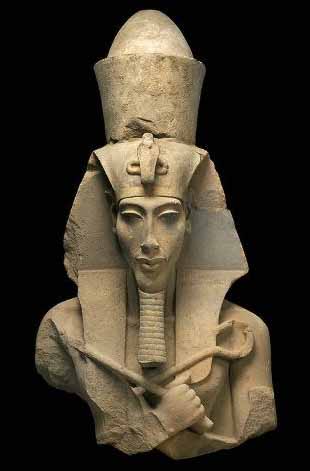
Amenhotep IV (Akhenaton)
|
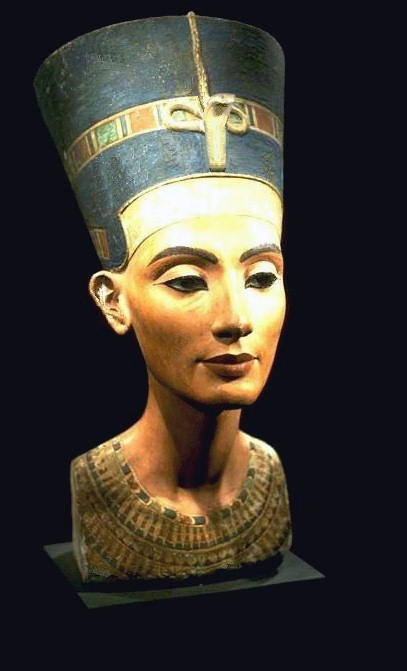
Akhenaton's
beautiful wife, Nefertiti
|
In 1375 B.C. Amenhotep
IV (Akhenaton), concerned about abuses in the Osiris cult
of Egypt, proposed a new monotheistic religion, perhaps the
first in world history, dedicated to the worship of the sun. He
moved the capital of Egypt from Thebes to El‑Amarna. The new
religion did not last long; the cult of Akhenaton was abolished
under the reign of his successor, the Pharaoh Tutankhamen
(1352-1344), who moved the capital back to Thebes and returned
to the old religion. Akhenaton's beautiful wife, Nefertiti,
achieved her own position in world history thanks to her famous
portrait bust with the elongated neck. These few years are above
all noted for the elegant and sensuous quality of the art works
they produced. The tomb of
Tutankhamen, discovered and excavated during the 1920s,
provided a large number of objects testifying to the
sophistication of the art produced at this period.
Rameses II 'the Great' (1304‑1237) built a new capital at the
Nile Delta, and reaffirmed Egyptian power. The Bible story of
Moses seems set in his reign. In 1182 his successor, Rameses III
drove the 'Sea People' out of Egypt; they went to the coasts of
Canaan and became the Philistines against whom David
waged major campaigns. Rameses III was the last great Egyptian
Pharaoh. In 750 B.C., the negroid inhabitants of Kush to the
south invaded Egypt and took power without destroying the main
culture; in 671, the Assyrians conquered Egypt in turn but
within ten years their empire collapsed and Egypt regained its
independence.
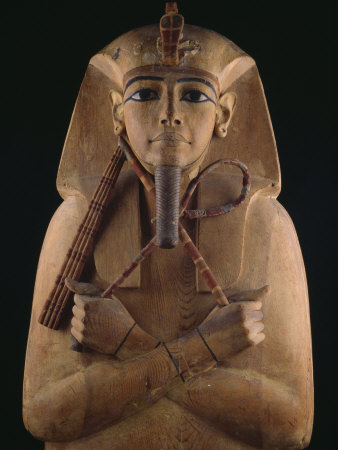
Coffin of Ramese II |
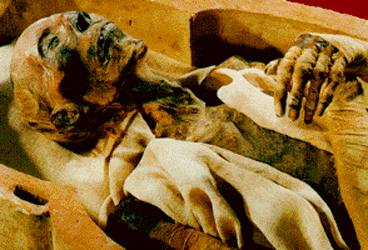
The mummified body of Rameses II
|
|
In 525 B.C. Cambyses,
the son of the great
Persian king Cyrus, took control of a much diminished Egypt;
from about 343 B.C. the Persians
ruled Egypt for a second time but in 332 ‑ 331, Alexander
the Great occupied Egypt and founded the city of Alexandria, where he was
finally buried. His secretary, known as Ptolemy, founded
a Hellenistic dynasty bearing his name in 305 and that family
continued to rule Egypt until 31 B.C. when the last queen, Cleopatra,
killed herself after the Battle
of Actium. For almost 3000 years the culture of Egypt
continued with little evolution; yet there is nothing
significant to report in philosophy or literature. Almost all
the land's energy and wealth went into the cult of the dead.

